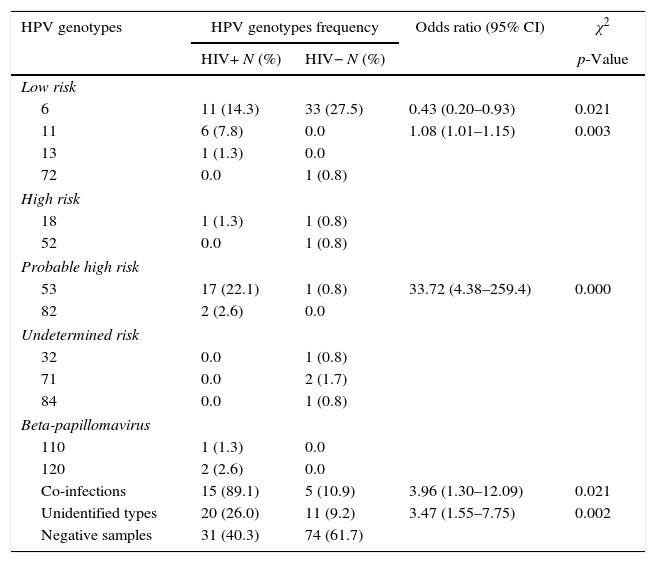Human papillomavirus (HPV) has been associated with the benign and malign diseases of the oral cavity, being considered a cofactor in human immunodeficiency virus (HIV) acquisition.1 Given the increased risk for HPV-associated oral diseases in HIV-positive patients, screening of HPV in healthy oral mucosa of these patients might be useful for epidemiology, preventive health measures, and treatment options.
In this way, we conducted a descriptive, case–control study in 197 individuals aged from 18 to 75 years and asymptomatic for oral lesions. The target group consisted of 77 HIV-positive individuals who attended at the University Hospital's ambulatory, Niterói City, Rio de Janeiro, Brazil, between 2009 and 2010. The control group included 120 volunteers from University Hospital's blood donors service, located in the same city. The Ethics Committee of the College of Medicine of the University provided ethical clearance for the protocol and informed consent, under the registration 357.085. Demographic and behavioral data were collected through a structured questionnaire. For HIV-positive people, CD4 counts were determined and plasma HIV-1 RNA levels were measured. An oral mucosal sample was harvested from all participants. The DNA extracted was submitted to PCR assay for HPV detection using MY09/11 consensus primers and HPV positive samples were typified by restriction fragment length polymorphism analysis (RFLP) or automated sequencing. A databank was generated in the SPSS-18 statistical packet to identify associations between variants and the presence of HPV.
Regarding HIV infection status, 68.4% of patients had undetectable HIV viral load, 76.6% reported HIV diagnostic more than 4 four years prior, and 88.3% were undergoing antiviral therapy. At the time of our study, 90.9% of patients had above 200 CD4+ cells/mL. Demographic variables did not affect HPV infection in HIV positive or negative people. However, oral HPV infection was significantly associated with HIV-positive individuals (59.7% versus 38.3%, p=0.004). Table 1 displays the spectrum of HPV genotypes found in oral cavity from both populations. They are categorized according to the criterion based on the risk for cervical cancer.2
Occurrence of oral HPV genotypes in HIV-positive and negative people.
| HPV genotypes | HPV genotypes frequency | Odds ratio (95% CI) | χ2 | |
|---|---|---|---|---|
| HIV+ N (%) | HIV− N (%) | p-Value | ||
| Low risk | ||||
| 6 | 11 (14.3) | 33 (27.5) | 0.43 (0.20–0.93) | 0.021 |
| 11 | 6 (7.8) | 0.0 | 1.08 (1.01–1.15) | 0.003 |
| 13 | 1 (1.3) | 0.0 | ||
| 72 | 0.0 | 1 (0.8) | ||
| High risk | ||||
| 18 | 1 (1.3) | 1 (0.8) | ||
| 52 | 0.0 | 1 (0.8) | ||
| Probable high risk | ||||
| 53 | 17 (22.1) | 1 (0.8) | 33.72 (4.38–259.4) | 0.000 |
| 82 | 2 (2.6) | 0.0 | ||
| Undetermined risk | ||||
| 32 | 0.0 | 1 (0.8) | ||
| 71 | 0.0 | 2 (1.7) | ||
| 84 | 0.0 | 1 (0.8) | ||
| Beta-papillomavirus | ||||
| 110 | 1 (1.3) | 0.0 | ||
| 120 | 2 (2.6) | 0.0 | ||
| Co-infections | 15 (89.1) | 5 (10.9) | 3.96 (1.30–12.09) | 0.021 |
| Unidentified types | 20 (26.0) | 11 (9.2) | 3.47 (1.55–7.75) | 0.002 |
| Negative samples | 31 (40.3) | 74 (61.7) | ||
HPV genotypes differed in HIV positive and negative people, in spite of non oncogenic types have predominated in both groups. The types that could not be identified by performed techniques were significantly higher in the group infected with HIV, being three times higher in those who had received HIV diagnosis less than 4 years prior (p=0.045). It can be that low immunity, yet not recovered by antiretroviral treatment, has favored the acquisition of unidentified HPV genotypes.
A significant association was found between HPV 53 and HIV infection, and the risk for it in the women oral cavity was about six times higher than in men (p=0.001). Concurrent oral HPV infections were likely to be more common in HIV-positive patients than in the health individuals (Table 1). When participants living or not with HIV infection were grouped to evaluate these outcomes (N=197), we verified that women carried out a significant high percentage of multiple infections (p=0.005).
The significant relationship between oral HPV 53 and HIV-infected women must be considered. In a former study, our research group detected HPV 53 among the most frequent types found in cervical samples of HIV-infected women.3 Despite both studies may not be linked because they were conducted with different HIV-infected populations, they point out the HPV 53 prevalence in both oral and genital sites of the HIV-infected women in a particular geographic area. Martins et al.4 also reported the HPV 53 as the most frequently genotype among cervical scrapes from HIV-positive women in the northeastern Brazil. In the same way, Palefsky et al.5 observed in cervical samples among the HIV-positive women that some low and probable risk HPV types, including HPV 53, were significantly more common among those with lower CD4 levels, and these also spanned the range of oncogenic risk. Therefore, the results described in the present study could suggest a high spread of HPV 53 genotype among HIV-infected population by oral/genital transmission.
Conflicts of interestThe authors declare no conflicts of interest.
This work was supported by Conselho Nacional de Desenvolvimento Científico e Tecnológico (CNPq No. 303560/2012-6), Pro-Reitoria de Pesquisa e Pós-Graduação da Universidade Federal Fluminense (PROPP-UFF), and Fundação de Amparo à Pesquisa do Estado do Rio de Janeiro (FAPERJ, No. E-26/111.255/2014). We thank the Plataforma de Sequenciamento de DNA of the Universidade Federal Fluminense and André Victor Barbosa for his technical assistance.






